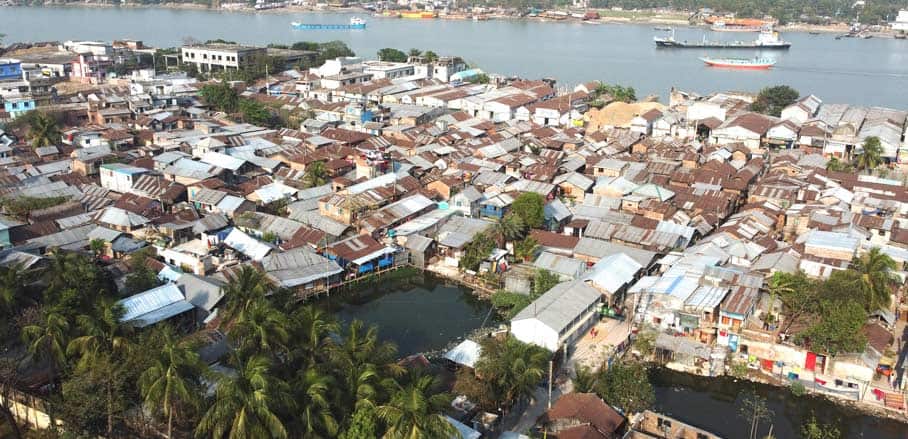Rethinking Resilience In Bangladesh’s Urban Slum Communities: An Experimental Thought
When thinking about the resilience of urban poor, it is worthwhile to think of resilience as a dynamic process of transition on individual and household level, argue Zakir Hossain and Mostafizur Rahman.
The asset-based community development approach (ABCD) aims to bring changes to urban slums through transferring assets to slum dwellers. In urban slums of Bangladesh, Community Development Committees (CDCs) act like gatekeepers, deciding where and when the urban slum communities will receive benefits; this decision depends on the amounts of assets available. Our experience shows that the asset-driven transformative development approach advances resilience at the community level, as it fosters investments in community infrastructure and helps build socio-economic facilities in the community.
Unfortunately, resilience at the individual and household level – unlike resilience at community level – remains a secondary aspect in the public discourse on resilience in urban slums of Bangladesh. We want to encourage to change that and suggest to include the importance of ‘enabling environment’ for individual and household resilience into the discourse. This perception allows to acknowledge the importance of equal opportunities in decision-making processes and of trustworthy relationships between slum dwellers and CDCs.
Some Thoughts on Resilience
In our earlier thoughts on climate change vulnerability and resilience of urban poor in Bangladesh, we evaluated the role of both cash and in-kind ABCD in upgrading the living conditions of urban slum communities. We know that ABCD is a process for mobilising assets, and developing the skill-sets of the communities to enable the individuals, households, and communities to utilise community-driven opportunities for strengthening the resilience.
CDCs have advanced community-driven slum upgrading schemes and collective savings provisions, and we noted that these have positively influenced aspects of resilience. However, we now realise that we had a narrow assumption of resilience, viewing it as something static instead of a dynamic and continuous process!
In fact, there is no single dimension of measuring resilience. Working in Rupsha Char slum and Railway Colony slum of Khulna city, Bangladesh, for the last couple of years, we have been able to make sense of a concept of resilience among urban poor that can be linked to creating an ‘enabling environment’. This concept perceives resilience as a ‘process-centric’ progression rather than a one-time resolution.
From Questions to Hidden Answers
Another question arises from the above discussion: have we been biased by our own interests when exploring resilience of urban poor? Or have we allowed our views of resilience to be contested, building upon a contextual understanding of the urban slum communities?
We have observed that the economic, social, environmental, and political features between urban slums of Bangladesh differ from each other. This is due to differences in engagement and interest of CDC members, who act as gatekeepers for upholding the asset transfer activities in urban slums and who guide the slum development approach through encouraging the involvement of the communities in building resilience.
For example, CDC members along with the close supervision of Ward Council Committee (smallest administrative unit of City Council) have built infrastructures like community toilets for improved health and hygiene, internal roads for better communication during the rainy season, and tube wells for ensuring safe drinking water in both Rupsha Char slum and Railway Colony slum.
The community resilience approach in urban slums may offer some visible infrastructural changes for the time being, but a conceptual thought on incorporating individual and household resilience can bring more sustainable answers to the resilience discourse in urban slums of Bangladesh. Importantly, this acknowledges the fact that, in reality, measures which only aim at the resilience of the community as a whole do not work.
The dominance of CDCs in slum development activities is an advantage, also because most members of the CDCs have been elected from among the slum communities themselves. Their activities allow for a new form of community resilience to emerge in urban slums: one that adopts the ideology of ‘development of communal resources’ as an integral part of resilience at individual and household levels.
Our experience on resilience in urban slum communities in Bangladesh suggests that the ABCD approach has somehow uplifted the economic status of the slum dwellers through creating employability and social status by upgrading the infrastructure linked to housing, roads, and sanitation facilities. We have also noted that increase in income opportunities and extension of social capital can act as key pathways to resilience.
However, greater income opportunities can also lead to an emergence of negative form of social behaviour such as gambling, drug use, and possibility of a second marriage by male household members. Yet, these negative forms of social behaviour seem not to be in effect immediately after the economic and social network improvement. Therefore, whenever we are to quantify and qualify the connection between asset-driven transformative development approach and resilience building, we tend to come to positive conclusions.
We can establish a link between our experiences and established knowledge on resilience: resilience is a dynamic process of transition that cannot be bound to one point in time. If we fail to acknowledge this, and only allow for a limited consideration of resilience’s temporality, we fail to capture that negative consequences may gain momentum through greater income opportunities.
Perceptions of Resilience in Bangladesh’s Urban Slums: Some Take-Aways
Considering the above, we emphasise the importance of including the aspect of ‘enabling environment’ into how we perceive resilience, and consider its relation to diverse economic, social, environmental, and political features of urban slums of Bangladesh. Furthermore, we need to consider the aspects of temporality in our perception of resilience. Lastly, we need to consider the individual and household level as starting points for conceptualising resilience.
